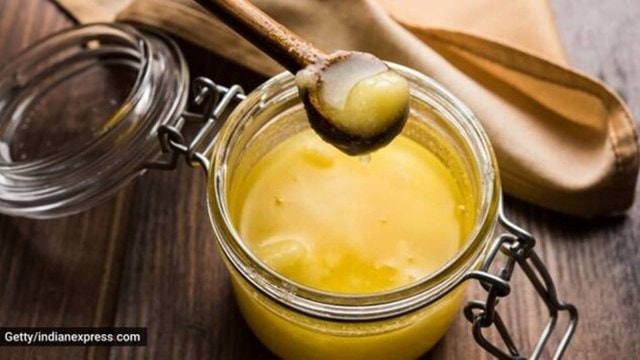- India
- International
Turns out, we have been cooking with ghee wrong all along
Kanikka Malhotra, consultant dietician and diabetes educator recommends using cookware with good thermal conductivity to ensure even heat distribution and prevent localised hot spots that can prematurely reach the smoke point
 While ghee's elevated smoke point suggests resilience to high temperatures, the appearance of smoke signals that a crucial safety threshold has been surpassed (Source: Getty Images/Thinkstock)
While ghee's elevated smoke point suggests resilience to high temperatures, the appearance of smoke signals that a crucial safety threshold has been surpassed (Source: Getty Images/Thinkstock)Ghee or clarified butter is the hero ingredient in many Indian dishes. Revered for its rich flavour, it has a high smoke point which makes it ideal for cooking at high temperatures.
But, according to some, there is a potential health hazard that is often overlooked: the sight of smoke emanating from ghee-filled pans.
Dietitian and digital creator Shreya Katyal, talks about this in her Instagram post. “Using ghee like this where you can see the smoke coming out, is dangerous for health,” she captions her post. While ghee’s elevated smoke point suggests resilience to high temperatures, the appearance of smoke signals that a crucial safety threshold has been surpassed, she indicates.
View this post on Instagram
Kanikka Malhotra, consultant dietician and diabetes educator tells indianexpress.com that this is in fact, true. “Heating ghee or oil above its smoke point converts good fats, such as polyunsaturated and monounsaturated fatty acids, into damaging free radicals such as aldehydes, hydrocarbons, and hydroperoxides.”
These free radicals can harm cells, she details, increasing inflammation and the risk of chronic diseases such as heart disease and some malignancies. “Furthermore, smoking oil produces acrolein, an irritant that can cause respiratory issues.”
Nisha, consultant dietician and nutritionist at Motherhood Hospitals, Gurgaon, adds, “Pregnant women should be even more careful when it comes to choosing cooking oils with high smoke points due to the potential impact on their health and the health of their developing baby.”

Exposure to harmful compounds released when oil reaches its smoke point, she says, can pose additional risks during pregnancy, including respiratory issues and oxidative stress.
Specific cooking techniques to help minimise the likelihood of ghee reaching its smoke point
Malhotra suggests using the following techniques to keep your ghee as wells as oils safe:
Choose the right oil:
*Ghee (smoke point ~482°F) is a good option for high-heat cooking like searing.
*For lower heat methods like sauteing, opt for refined options like:
- Mustard oil (smoke point ~400°F) adds a pungent flavour, perfect for tadka.
- Rice bran oil (smoke point ~400°F) is neutral-flavoured and versatile.
- Groundnut oil (smoke point ~430°F) is another good all-purpose choice.
Gradual Heating: Slowly bring your oil or ghee to cooking temperature to avoid reaching the smoke point too quickly.
Use the Right Amount: Don’t overcrowd the pan. This cools the oil and lowers its smoke point. Fry food in batches for better temperature control.
 Use cookware with good thermal conductivity (e.g., cast iron) to ensure even heat distribution and prevent localised hot spots. (Source: Freepik)
Use cookware with good thermal conductivity (e.g., cast iron) to ensure even heat distribution and prevent localised hot spots. (Source: Freepik)
How to adapt cooking practices to ensure you’re using ghee or oil safely
According to Malhotra, leverage the unique smoke points of different fats. Sauté aromatics in a low-smoke point oil (e.g., mustard oil) to extract flavour. Then, for high-heat steps like searing, introduce ghee to take advantage of its high smoke point without compromising the delicate flavour compounds from the initial oil.
“Maillard reaction, responsible for the desirable browning and caramelisation in food, can occur at lower temperatures. Reduce heat slightly and cook for a longer duration to achieve the same flavour profile while minimising oil breakdown,” she suggests.
She also recommends using cookware with good thermal conductivity (e.g., cast iron) to ensure even heat distribution and prevent localised hot spots that can prematurely reach the smoke point. A preheated pan also promotes faster cooking, minimising oil exposure to high temperatures.
Depending on the dish, explore healthier fats with higher smoke points. For example, swap some ghee in baking with avocado oil (smoke point ~520°F) for its similar monounsaturated fatty acid profile while maintaining a high smoke point for even heat distribution, says Malhotra.
“Add herbs and spices rich in antioxidants (e.g., turmeric, rosemary) during cooking. These antioxidants can help scavenge free radicals formed during the heating process, potentially mitigating some of the negative health effects.”
Buzzing Now
Jun 02: Latest News
- 01
- 02
- 03
- 04
- 05

























